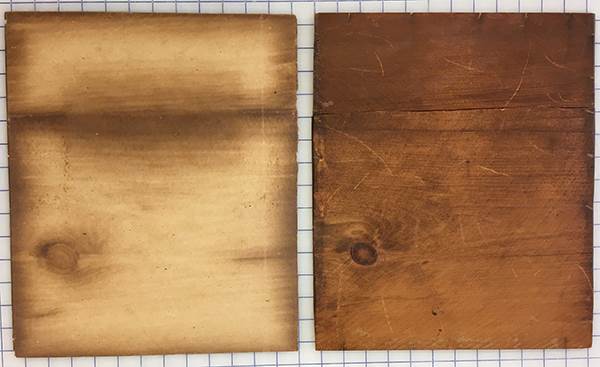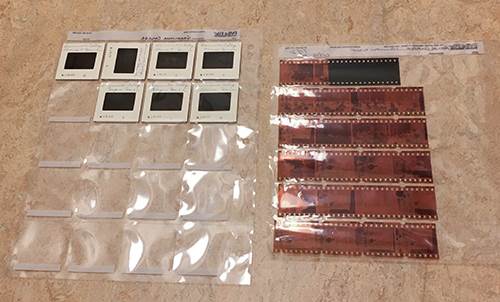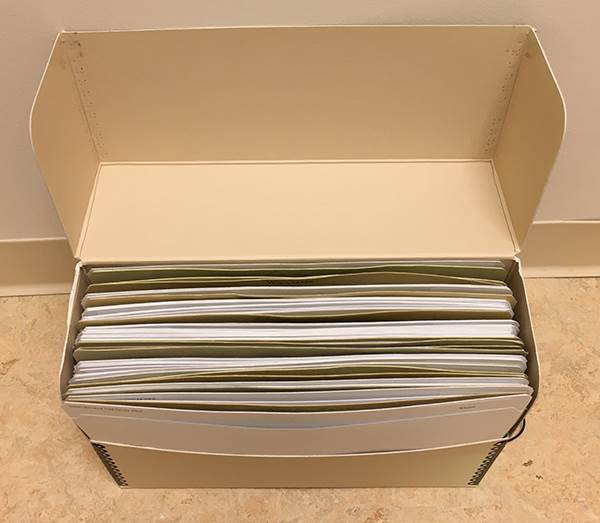By Bonnie Parr
One important element of preserving family history materials is to store them in archival quality enclosures, meaning something made of stable materials that won’t react with their contents. This is significant because enclosures are in direct contact with their contents and part of the immediate environment around them. Poor quality materials cause deterioration because of their acidity and outgassing products. Always replace old or suspect enclosures with archival quality materials.
 An example of acid migration. The wood on the right was used as a backing board for a framed item. The paper on the left was in direct contact and has absorbed the acidity of the wood, creating a "shadow."
An example of acid migration. The wood on the right was used as a backing board for a framed item. The paper on the left was in direct contact and has absorbed the acidity of the wood, creating a "shadow."
Because “archival quality” is not a recognized or enforced standard, look for suppliers recommended in literature or websites about preservation or consult with libraries and museums that have conservation or preservation departments.
Three suppliers specializing in materials for archival storage are:
Archival enclosures are available in a dizzying variety of styles including folders, cover sheets, page protectors, sleeves, envelopes, binders, and boxes. This article discusses what to look for in choosing enclosures made of paper or plastic.
Paper products must be acid free and free of lignin content (a component of wood products that darkens when exposed to light). Archival paper products are available as either buffered or unbuffered.
Buffered paper has an alkaline additive that makes it resistant to absorbing acids from the surrounding environment. It is appropriate for the storage of most books, documents, black and white photographs and negatives, photographs mounted on brittle boards, and textiles with fibers originating from plant sources (cotton, linen).
Unbuffered paper is acid free but does not have an alkaline additive. It is not resistant to acidic deterioration. Unbuffered enclosures should be replaced periodically or stored inside larger buffered enclosures (such as an unbuffered envelope stored inside a buffered box). It is appropriate for the storage of color photographs and negatives, albumen photographs, blueprints, items with sensitive dyes or coatings, and textiles with fibers originating from animal sources (wool or silk).
Advantages of paper enclosures include porosity (which allows for dissipation of moisture and gases), protection of contents from exposure to light, dust, and air pollutants (because paper is opaque), and support for fragile items (depending on the thickness of the paper). Paper products are less expensive than plastic enclosures and they are easy to write on.
The major disadvantage of paper products is that contents must be removed to view, increasing the potential for damage from extra handling, abrasion, and fingerprinting.
Plastic products must be inert, which means they are chemically stable with no coatings, plasticizers, or additives. Currently acceptable plastics include polyester film, polyethylene, and polypropylene.
Polyester film is transparent, dimensionally stable, and somewhat stiff. Polyethylene has a filmy appearance, is flexible, and inexpensive. High-density polyethylene is naturally slippery and is preferred over low-density polyethylene, which has additives. Polypropylene is heat resistant and acts as a barrier against moisture and vapors. The uncoated version of polypropylene is as rigid as polyester. Softer versions of polypropylene – often used for page protectors – have proprietary surface treatments which may or may not be archival. Always check specifications for polypropylene storage products.
 Slides and negatives stored properly in protective sleeves
Slides and negatives stored properly in protective sleeves
Never use products with vinyl in the name, especially polyvinylchloride (PVC). Vinyl products are chemically unstable and emit a strong smell as they degrade. This smell, called “outgassing”, can aggressively deteriorate paper. A rule of thumb regarding choosing plastic for the storage of historical materials: if it smells “plastic-y”, don’t use it!
Advantages of plastic enclosures include transparency (allowing viewing of contents without removing them from their enclosures, thus reducing the amount of direct handling), durability, and providing a barrier to moisture and air pollutants.
Disadvantages of plastic enclosures include no protection from light (unless the plastic enclosure is housed inside a paper enclosure – such as a plastic sleeve stored inside a paper envelope), can develop an electrostatic charge (which will attract dust and pull off flaking media – such as pastels, charcoal, pencil, and loose image layers of photographs), is more expensive that paper products, and is difficult to label (though special film marking pens are available). Plastic is not breathable, so in high humidity conditions outgassing products of contents and moisture can be trapped inside enclosures.
Whether using paper or plastic, choose enclosures that completely cover their contents, are sturdy enough to hold the weight of their enclosed items, are large enough for items to be easily inserted and removed without resistance, and are appropriately sized so the contents can lay flat or stand upright without danger of tearing, folding, or bending.
 Documents stored properly in a sturdy, acid-free box.
Documents stored properly in a sturdy, acid-free box.
Bonnie Parr is the ALPLM's historical documents conservator.